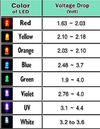As in previous threads, my outdoor LED light strings mostly fail during the winter season. Only about 1/3 remain lit after about 4 months. Last year, I filled each socket with silicone paste to no avail.
I chose the socketed ones so that I can make them multi-colored.
I see no other option but to cut them apart and rewire each LED in parallel and use a low voltage DC power supply. Strings of 50 lites would be ideal for me.
Since adding a resistor for each LED would be rather tedious, the hope is to power entire the string at the right voltage. This is where I need help.
5 volt USB power supplies are fairly cheap and easy to come by but are to high for the LEDs. Maybe I could use them with one 2 or 3 watt resistor.
Please offer your thoughts.


I chose the socketed ones so that I can make them multi-colored.
I see no other option but to cut them apart and rewire each LED in parallel and use a low voltage DC power supply. Strings of 50 lites would be ideal for me.
Since adding a resistor for each LED would be rather tedious, the hope is to power entire the string at the right voltage. This is where I need help.
5 volt USB power supplies are fairly cheap and easy to come by but are to high for the LEDs. Maybe I could use them with one 2 or 3 watt resistor.
Please offer your thoughts.

